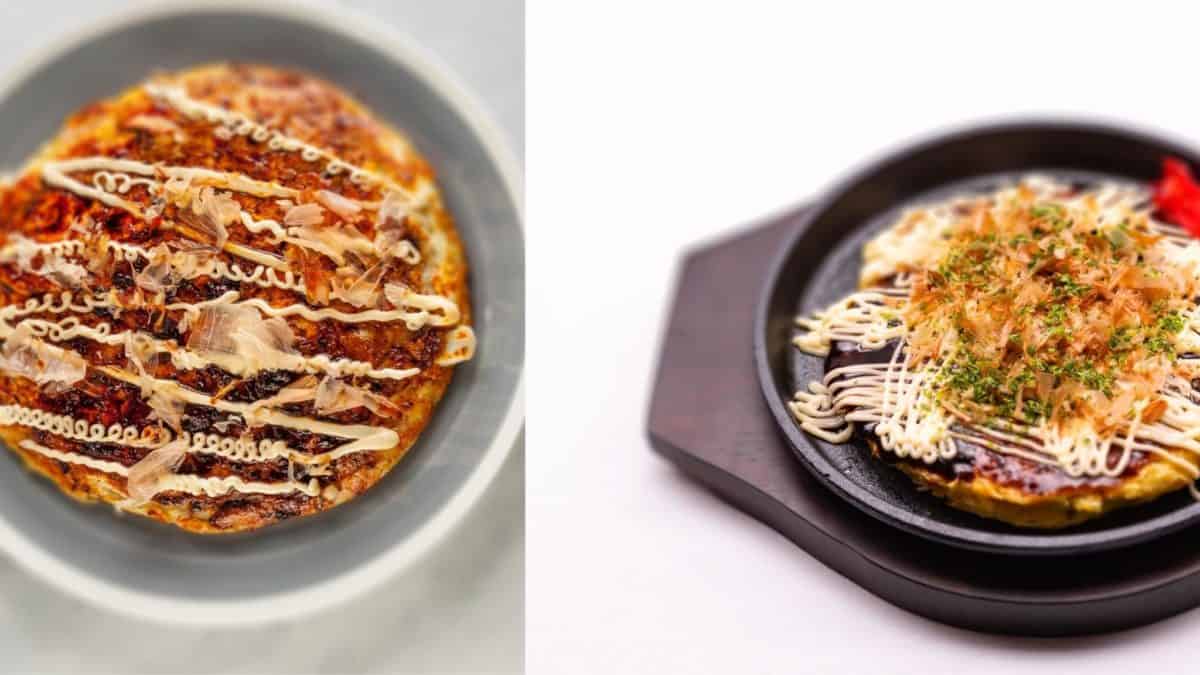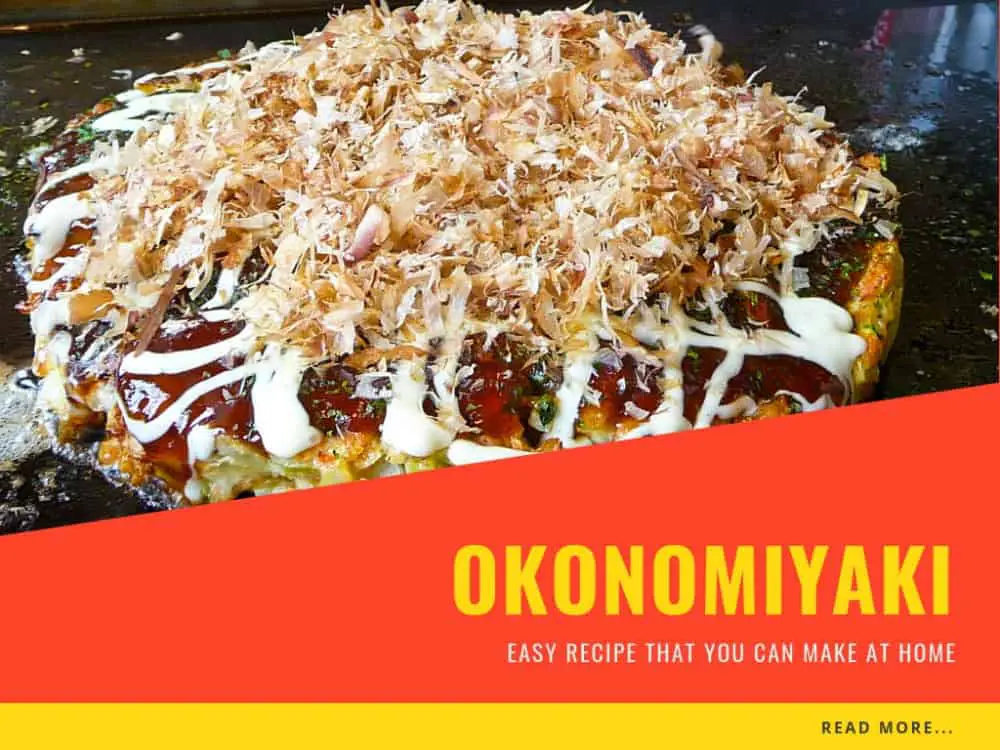Okonomiyaki: “grill anything that you want” pancakes
Okonomiyaki is a Japanese savory pancake containing a variety of ingredients.
That’s kind of the point since the name is derived from the word okonomi, meaning “what you like” or “what you want”, and yaki meaning “grilled” or “cooked”.
Okonomiyaki is mainly associated with the Kansai or Hiroshima areas of Japan, but is widely available throughout the country. Toppings and batters tend to vary according to region. Tokyo okonomiyaki is usually smaller than a Hiroshima or Kansai okonomiyaki.

It is believed by food researcher Tekishū Motoyama to have been derived from the funoyaki, a thin crepe-like confection that was popular in Japan back in the 16th century (Sengoku period), which was often served as a snack to children.
Later on, this simple snack recipe spread to Kyoto, Osaka, and then to Edo (modern day Tokyo). It was dubbed gintsuba and kintsuba, respectively.
In the Meiji Era, it was called mojiyaki, but it wasn’t after the 1923 Great Kantō earthquake (Taishō Era) when the okonomiyaki began taking its current form.
Besides the common sweet types, savory types using fish, vegetables, and various meat began appearing when people cooked these crepes to make them into meals with whatever ingredients they had in the region.
And again, during the Second World War, when Japan experienced a rice shortage, the okonomiyaki finally became recognizable in the form that it has today, with basic ingredients.

Check out our new cookbook
Bitemybun's family recipes with complete meal planner and recipe guide.
Try it out for free with Kindle Unlimited:
Read for freeIn this post we'll cover:
What do you cook okonomiyaki on?
Okonomiyaki is cooked on a teppan, the same large flat grill surface for teppanyaki-style cooking. This is because the chef has to be able to spread the batter thinly to make the bottom crispy, and still be able to mash the batter together with the ingredients.
Types of Okonomiyaki and regional variations
It’s interesting to know that places like Tsukishima, Hinase, Tokushima Prefecture, and a few other regions have their own unique style of cooking the okonomiyaki meaty-vegetable pancake.
The evolution of okonomiyaki is a wonder in and of itself. Now, let’s look at the different variations of this Japanese savory pancake.
Okonomiyaki comes in these different styles of cooking:
- Kansai/Osaka style
- Hiroshima style
- Tsukishima style
- Hamamatsu style
- Okinawa style
- Hinase, Okayama style
- Kishiwada, Osaka style
- Fuchū, Hiroshima style
- Tokushima style

This is a text overlay image of the original work Okonomiyaki! by SteFou! on Flickr under cc. What a great looking dish!
Kansai/Osaka style
This particular version of the okonomiyaki is the most popular among all of the okonomiyaki pancakes in all of Japan.
Dissecting this dish will be tough, as it has lots of basic ingredients. And since its name implies that you can customize it, that becomes even more complicated.
- Starting off with the batter, it’s made from wheat or buckwheat flour and sort of forms the foundation for the whole pancake.
- Then, other ingredients include a tuberous root vegetable called nagaimo, which is a type of yam that’s grated.
- Dried kelp or skipjack tuna extract called dashi, or sometimes, they just use water as a substitute ingredient.
- Shredded cabbage (these are the perfect ones to use for okonomiyaki!) and eggs.
- Additional ingredients include mochi or cheese, konjac, vegetables, shrimp, squid, octopus, thin strips of pork belly meat (looks very similar to bacon), and green onion.
The various slang for okonomiyaki may also include “Osaka soul food”, “Japanese pizza”, pancake, or omelet.
Okonomiyaki also has very delicious toppings, which add even more taste to the already very present flavors. These condiments include:
- Beni shōga or pickled ginger
- Japanese mayonnaise
- Katsuobushi or what’s otherwise known as bonito flakes
- Aonori (seaweed flakes)
- Worcestershire sauce or otafuku/okonomiyaki sauce
The okonomiyaki is cooked atop a teppanyaki grill and you may go to either a staff-served or grill-it-yourself restaurant where the latter will give you the freedom to cook your own okonomiyaki.
There are also other variants of okonomiyaki where they serve it with an additional layer of fried udon/yakisoba, and it’s called modan-yaki. Negiyaki, on the other hand, is a type of okonomiyaki with lots of scallions.
Hiroshima style
The Hiroshima cooking style of the okonomiyaki is sometimes referred to as Hiroshima-yaki or Hiroshima-okonomi.
This okonomiyaki style is quite distinct from its Osaka counterpart. While the ingredients of the latter are mixed, the former’s is layered with rock-like formations detailing geological timelines.
The layers commonly consist of:
- Baked flour batter
- Cabbage
- Pork (or seafood items such as octopus, squid, or shrimp)
- Cheese
- Typically, it’s topped with udon or yakisoba noodles, much like the modan-yaki
- Plus enough okonomiyaki sauce to blow all your blues away, simply because it’s very delicious.
This okonomiyaki has such a unique blend and taste to it that you’d recite the Japanese idiomatic expression, “花より団子”, which translates to “dumplings rather than flowers”. It can generally mean someone who prefers substance over style, or is a practical person.
In my collective assumption, the practicality of layering the okonomiyaki’s ingredients rather than mixing them enhances its taste more!
Tsukishima style
Specializes in monjayaki as this is believed to be the place where the monjayaki was born, but restaurants here also offer okonomiyaki.
They even named the main street here “Monja Street” as a reference to the monjayaki recipe.
Hamamatsu style
They cook takuan. This is pickled daikon radish and hardly considered as a type of okonomiyaki, except for its vegetable pancake-ish looks.
Okinawa style
This is a very simple type of okonomiyaki called hirayachi, but you’ll find it more often in households rather than in any restaurant in Okinawa.
Hinase, Okayama style
Chefs from this region love to put oysters in the okonomiyaki and improve upon the recipe to call it kaki-oko, which is their version of the famous cuisine.
Kishiwada, Osaka style
Their version of the okonomiyaki is called kashimin-yaki (カシミヤキ). The usual pork meat that’s added to the recipe is replaced with chicken and tallow, which gives the kashimin-yaki its unique flavor.
Fuchū, Hiroshima style
This version of the okonomiyaki has also replaced the pork meat belly in favor of ground beef or pork.
Tokushima style
This is a type of mixed okonomiyaki.
Hashimaki
This is kind of a style of okonomiyaki, but hashimaki comes served on chopsticks, ready to eat
Popular okonomiyaki pairings
Okonomiyaki, a Japanese savory pancake, is delicious on its own. But pair it with the right ingredients and you have a meal that’s even more amazing. Here are some of our favorite okonomiyaki combinations.
-Okonomiyaki with bacon and cheese
-Okonomiyaki with shrimp and scallops
-Okonomiyaki with chicken and mushrooms
-Okonomiyaki with beef and onions
Similar dishes
Okonomiyaki is called modanyaki when a layer of fried noodles (either udon or yakisoba) is added.
It’s believed that this term come from the borrowed English word “modern,” or was formed by blurring the 2 words “mori” and “dakusan”, which means “piled high” or “a lot”, referring to the obvious increase of ingredients.
Okonomiyaki also has a “light” or thinner version that’s called negiyaki, which is defined by a large number of scallions in its ingredients when compared to the normal okonomiyaki. It’s comparable to Korean pajeon and Chinese green onion pancakes.
If you’re looking for something similar to okonomiyaki, try takoyaki or yakisoba. Both dishes are made with a batter and grilled, but takoyaki contains octopus pieces and yakisoba is stir-fried noodles.
Also, monjayaki is a great dish that is very similar but with a runny batter and served in a bowl instead of on a plate.
Read more: these are the differences between Japanese noodles
Okonomiyaki is smiliar to teppanyaki: it’s entertainment cooking
There are quite a number of similarities between the teppanyaki cooking style and how chefs prepare okonomiyaki.
Chief among them is the cooking of ingredients over a flat top iron griddle, where stir-frying the food is mostly done.
Although chefs that cook okonomiyaki inherently don’t entertain their guests as teppanyaki chefs do, their cooking actions make everything entertaining to onlookers.
Where to eat okonomiyaki?
If you’re ever in Osaka, Japan, be sure to check out Dotonbori. This famous food street is lined with okonomiyaki restaurants, each with its own unique twist on the dish.
Okonomiyaki etiquette
When eating okonomiyaki, it’s important to remember a few things. First, use your chopsticks to mix everything together before taking a bite. And second, be sure to share! Okonomiyaki is meant to be eaten family-style, so everyone can enjoy the flavors and textures of this delicious dish.
Health benefits of okonomiyaki
Not only is okonomiyaki delicious, it’s also packed with nutrients. The veggies in the pancake provide vitamins and minerals, while the protein-rich ingredients help to fill you up.
Conclusion
Okonomiyaki is a delicious, hearty dish that is perfect for sharing. Be sure to try it if you’re ever in Osaka, Japan! And don’t forget the chopsticks!
Also read: this is a delicious and pretty simple okonomiyaki recipe
Check out our new cookbook
Bitemybun's family recipes with complete meal planner and recipe guide.
Try it out for free with Kindle Unlimited:
Read for freeJoost Nusselder, the founder of Bite My Bun is a content marketer, dad and loves trying out new food with Japanese food at the heart of his passion, and together with his team he's been creating in-depth blog articles since 2016 to help loyal readers with recipes and cooking tips.

